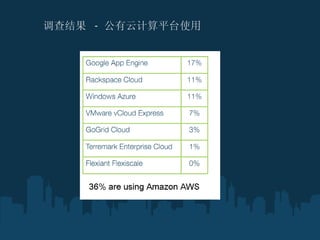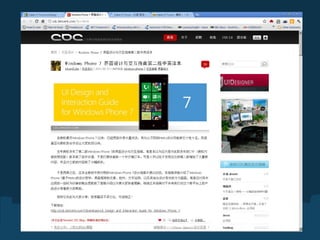Using google appengine_final
- 1. 使用 Google AppEngine 建立个人信息中心 weibo.com/sagasw 2011-11
- 3. Agenda 1 )云计算那些事儿 2 ) GoogleAppEngine 简介 3 ) GAE 搭建个人信息中心 4 )相关资源介绍
- 4. 调查 1 ) Python 语言? 2 ) Google AppEngine ? 3 )云计算平台?
- 5. 1 )云计算那些事儿
- 6. IaaS (Infrastructure as a Service) Amazon EC2 , Microsoft Azure PaaS (Platform as a Service) GoogleAppEngine , SinaAppEngine , HeroKu, DotCloud SaaS (Software as a Service) Zoho , Google Apps ,易度
- 7. 云平台比较 http://www.eecs.berkeley.edu/Pubs/TechRpts/2009/EECS-2009-28.pdf
- 8. 调查结果 - 公有云计算平台使用
- 9. 新浪微博 @_ 浪潮之巅 _ : 中国很多大公司 ( 主要是央企 ) ,对云计算理解就是 IDC 和设备。 美国的 case 都是应用。美国这点认识比较一致: IDC 和最基础的东西让 Google , Facebook 和 Amazon 去做。 http://weibo.com/2142166543/xtKu40qgP
- 12. 2 ) Google AppEngine 简介
- 13. Google AppEngine 云计算平台。支持 Go, Python, Java (JRuby, Rails etc.) ,有免费 Quota 。 优点: UrlFetch,Memcache,TaskSchedule XMPP,Mail,Cron MapReduce,Channel 支持 OAuth 认证或 Google 账号 Image 处理 域名绑定 易使用,易管理 免费限额大方 缺点 : 无全文搜索 调整后的付费方案 需要熟悉新 SQL 操作方式
- 14. 适用于: Wiki,CMS, 博客 , 微博 , 手机游戏后台 , 应用服务器 , 问答网站 , 电子书发布 ,SNS, 网店 , 工作流 不适合: 音频视频服务 , 大文件 , 密集计算 Google AppEngine 适用业务领域
- 15. Django WebApp2 Tornado https://github.com/facebook/tornado/tree/master/demos/appengine Google AppEngine Web Framework
- 16. GAE 支持的 Python libraries BeautifulSoup, FeedParser, PythonTwitter, Readability PIL, PyCrypto, lxml 等等 什么样的 library 可直接用于 GAE ? 不依赖 C 扩展 不使用数据库 不访问本地资源 http://pypi.python.org/pypi
- 17. Java on AppEngine Play! Framework http://www.slideshare.net/gasolin/play-framework-on-google-app-engine https://github.com/guillaumebort/play-gae Scala Lift Framework http://lift-example.appspot.com/ http://www.scala-lang.org/node/1826 JavaScript http://www.appenginejs.org/
- 18. JRuby on Google AppEngine code.google.com/p/appengine-jruby/ github.com/jruby/jruby-rack
- 19. Lua on Google AppEngine http://code.google.com/p/aelua/ http://code.google.com/p/jillcode/ http://code.google.com/p/kahlua/ https://github.com/krka/kahlua2 http://sourceforge.net/projects/luaj/
- 21. GAE SDK 1.5.5 Changes (Latest 1.6.0) Python 2.7 支持 支持多线程,可使用 threading 支持并发请求 支持更多 Python lib ( PIL v1.1.7 )。 前台请求的时间 30 秒增加到 60 秒, URLFetch 请求时间从 10 秒增加到 60 秒。 TaskQueue 响应时间增加。 From Keakon's blog
- 22. GAE 编程优化心得 尽量使用 MemCache 组合 GoogleAppEngine & VPS 通过 webservice 访问 VPS 数据库, GAE 缓存结果 使用 google 或 VPS 搭建搜索功能 Nginx 反向代理 GAE (必须的) VPS seller and coupon http://www.lowendbox.com/ Install Debian, Nginx in VPS http://www.howtoforge.com/
- 23. Google AppEngine 后台管理
- 24. 3 ) GAE 建立个人信息中心
- 25. 常用的个人信息服务列举 TwitterWeb 客户端,同步到新浪腾讯微博 RSS 聚合阅读 获取网页,解析短网址 Cron Jobs 在线个人笔记,在线个人博客 网络小说阅读 推送文章到 Kindle 每日定时发送天气短信给自己或家人 生日提醒(邮件,聊天工具,短信等) 监控 iPhone 预订网页的内容变化 相册 Webproxy
- 26. 已实现的功能及实现方式 1 )选择现成代码修改( Doodle, V2ex, GaeBBS ) 2 )同步发推 , 新浪微博功能, t.co 短网址 3 )定期采集 RSS 4 )支持 Google Reader share 5 ) HackerNews 全文阅读 6 )网页内容变化,通过短信提醒 7 )支持 XMPP 协议( gtalk )客户端自动聊天 8 )网络小说 web client 9 )发送 Flickr 每日 interesting 图片到新浪微博
- 27. 同步到新浪微博 import mechanize br = mechanize.Browser() br.open("http://abcd.com/weibosdk/weibopost.php") br.select_form(nr=0) strform = status.encode('utf-8') br.form['text'] = str br.submit() 需要 VPS 上搭建微博 PHP SDK 作中转 或者使用 SinaAppEngine 作为中转
- 28. BeautifulSoap from BeautifulSoup import BeautifulSoup VALID_TAGS = ['strong', 'em', 'p', 'ul', 'li', 'br', 'img', 'ol', 'blockquote'] def sanitize_html(value): soup = BeautifulSoup(value) for tag in soup.findAll(True): if tag.name not in VALID_TAGS: tag.hidden = True return soup.renderContents()
- 29. 抓取网页 ( Webproxy ) https://gist.github.com/1298152
- 33. 推特客户端
- 37. 免费 Quota 统计
- 39. 实例一 发送 flickr 图片到新浪微博 Cron 任务采集 flickr 的 explore 图片 访问图片网址,获取 favor 信息(确定是否 post ) 建立 task ,投递到 taskqueue (使用 ETA ) 在 SAE 上搭建中转服务 Mechanize 模拟 form submit 访问 SAE Fix bug ,调整参数
- 42. 示例二 Mobile01 阅读 分析网页内容 设计抓取方式 HTML readability viewtext.org, www.instapaper.com/m?u = Readitlaterlist api 下载图片 添加文章
- 47. 总结 好玩很重要 云计算平台值得投入时间了解学习 推荐使用 Python + Tornado 组合 WebService, API 的 Mashup 设计思路
- 48. Q & A



























![同步到新浪微博 import mechanize br = mechanize.Browser() br.open("http://abcd.com/weibosdk/weibopost.php") br.select_form(nr=0) strform = status.encode('utf-8') br.form['text'] = str br.submit() 需要 VPS 上搭建微博 PHP SDK 作中转 或者使用 SinaAppEngine 作为中转](https://image.slidesharecdn.com/usinggoogleappenginefinal-111117195521-phpapp02/85/Using-google-appengine_final-27-320.jpg)
![BeautifulSoap from BeautifulSoup import BeautifulSoup VALID_TAGS = ['strong', 'em', 'p', 'ul', 'li', 'br', 'img', 'ol', 'blockquote'] def sanitize_html(value): soup = BeautifulSoup(value) for tag in soup.findAll(True): if tag.name not in VALID_TAGS: tag.hidden = True return soup.renderContents()](https://image.slidesharecdn.com/usinggoogleappenginefinal-111117195521-phpapp02/85/Using-google-appengine_final-28-320.jpg)

































































